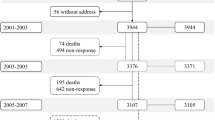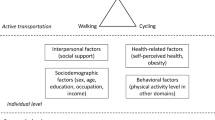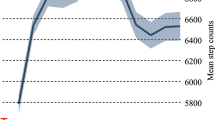Abstract
Objective:
Stair climbing is highlighted as a component of a regiment of daily physical activity by various health agencies. This study examined the association between daily stair climbing, as measured by floor of residence in buildings without elevators, and body mass index (BMI).
Methods:
We analyzed data from a cross-sectional survey of housing and health, conducted by the WHO in eight European cities in 2002 and 2003. BMI was computed from self-reported height and weight; respondent and housing characteristics were also included in regression models that accounted for the clustering of respondents within the same household.
Results:
Among 2846 normal weight adults, there was an interaction between floor of residence and sex (P=0.017). Among men, residence on a higher floor was significantly associated with lower BMI (P=0.003); BMI of men residing on the fourth floor or above was 0.88 lower than men residing on the first floor. Among women, there was no significant association between floor of residence and BMI (P=0.161).
Conclusions:
These results suggest an association between daily stair climbing and BMI among men but not among women. If replicated, these results support initiatives encouraging stair climbing as a path toward physical fitness among men.
This is a preview of subscription content, access via your institution
Access options
Subscribe to this journal
Receive 12 print issues and online access
$259.00 per year
only $21.58 per issue
Buy this article
- Purchase on Springer Link
- Instant access to full article PDF
Prices may be subject to local taxes which are calculated during checkout
Similar content being viewed by others
References
Salmon P . Effects of physical exercise on anxiety, depression, and sensitivity to stress: a unifying theory. Clin Psychol Rev 2001; 21: 33–61.
World Health Organization. Move for health: benefits of physical activity. http://www.who.int/moveforhealth/advocacy/information_sheets/benefits/en/index.html Accessed 5 January 2007.
Sallis JF, Hovell MF . Determinants of exercise behavior. Exerc Sport Sci Rev 1990; 18: 307–330.
World Health Organization . Move for health: sedentary lifestyle: a global public health problem. http://www.who.int/moveforhealth/advocacy/information_sheets/sedentary/en/index.html.Accessed 5 January 2007.
Leon AS, Casal D, Jacobs Jr D . Effects of 2000 kcal per week of walking and stair climbing on physical fitness and risk factors for coronary heart disease. J cardiopulm Rehabil 1996; 16: 183–192.
Engbers LH, van Poppel MN, van Mechelen W . Modest effects of a controlled worksite environmental intervention on cardiovascular risk in office workers. Prev Med 2006; December 20.
Boreham CA, Kennedy RA, Murphy MH, Tully M, Wallace WF, Young I . Training effects of short bouts of stair climbing on cardiorespiratory fitness, blood lipids, and homocysteine in sedentary young women. Br J Sports Med 2005; 39: 590–593.
World Health Organization. The LARES project (Large analysis and review of European housing and health status). http://www.euro.who.int/Housing/Activities/20020711_1.Accessed 5 January 2007.
Braveman PA, Cubbin C, Egerter S, Chideya S, Marchi KS, Metzler M et al. Socioeconomic status in health research: one size does not fit all. JAMA 2005; 294: 2879–2888.
Rose G . The Strategy of Preventive Medicine. Oxford University Press: New York, NY, 1992.
Betz NE, Mintz L, Speakman G . Gender differences in the accuracy of self-reported weight. Sex Roles 1994; 30: 543–552.
Villanueva EV . The validity of self-reported weight in US adults: a population based cross-sectional study. BMC Public Health 2001; 1: 11.
Vague J . The degree of masculine differentiation of obesities: a factor determining predisposition to diabetes, atherosclerosis, gout, and uric calculous disease. Am J Clin Nutr 1956; 4: 20–34.
Department of Health and Human Services. Small Step Program. http://www.smallstep.gov.Accessed 5 January 2007.
Dolan MS, Weiss LA, Lewis RA, Pietrobelli A, Heo M, Faith MS . Take the stairs instead of the escalator': effect of environmental prompts on community stair use and implications for a national ‘Small Steps’ campaign. Obes Rev 2006; 7: 25–32.
Pate RR, Pratt M, Blair SN, Haskell WL, Macera CA, Bouchard C et al. Physical activity and public health. A recommendation from the Centers for Disease Control and Prevention and the American College of Sports Medicine. JAMA 1995; 273: 402–407.
Webb OJ, Eves FF . Promoting stair climbing: effects of message specificity and validation. Health Educ Res 2007; 22: 49–57.
Acknowledgements
Author contributions: Edmond Shenassa had full access to all of the data in the study and takes responsibility for the integrity of the data and the accuracy of the data analysis.
Study concept and design: Shenassa, Daskalakis
Acquisition of data: Shenassa, Braubach.
Analysis and interpretation of data: Shenassa, Frye.
Drafting of the manuscript: Frye, Shenassa, Daskalakis.
Critical revision of the manuscript for important intellectual content: Shenassa, Frye, Daskalakis.
Statistical analysis: Frye, Daskalakis.
Obtaining funding: N/A.
Administrative, technical, or material support: Shenassa, Braubach, Frye.
Supervision: Daskalakis.
Author information
Authors and Affiliations
Corresponding author
Additional information
Financial Disclosures: N/A.
Funding/Support: N/A.
Role of the Sponsor: N/A.
Rights and permissions
About this article
Cite this article
Shenassa, E., Frye, M., Braubach, M. et al. Routine stair climbing in place of residence and Body Mass Index: a pan-European population based study. Int J Obes 32, 490–494 (2008). https://doi.org/10.1038/sj.ijo.0803755
Received:
Revised:
Accepted:
Published:
Issue Date:
DOI: https://doi.org/10.1038/sj.ijo.0803755
Keywords
This article is cited by
-
Housing as an obesity-mediating environment
International Journal of Public Health (2012)



